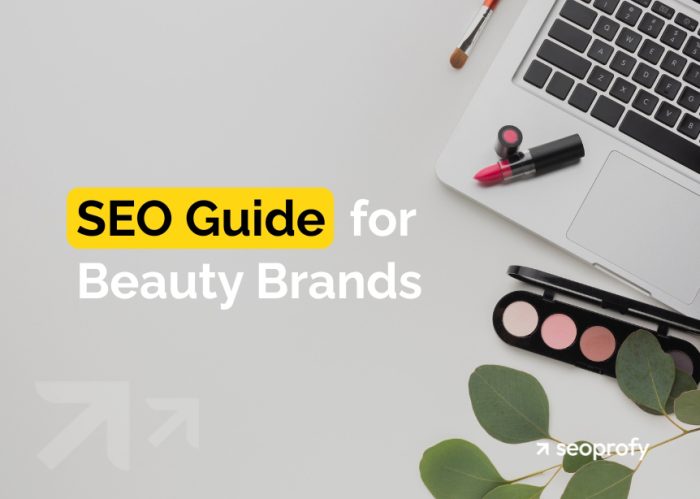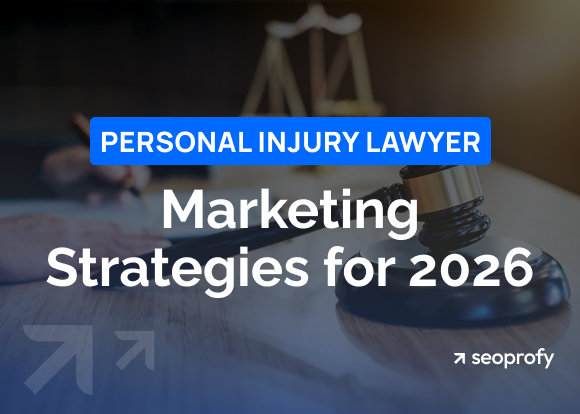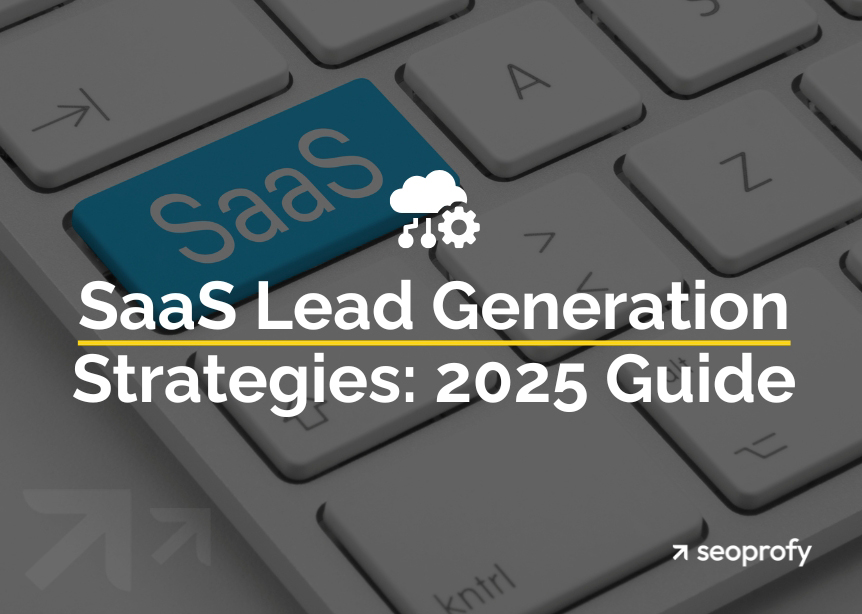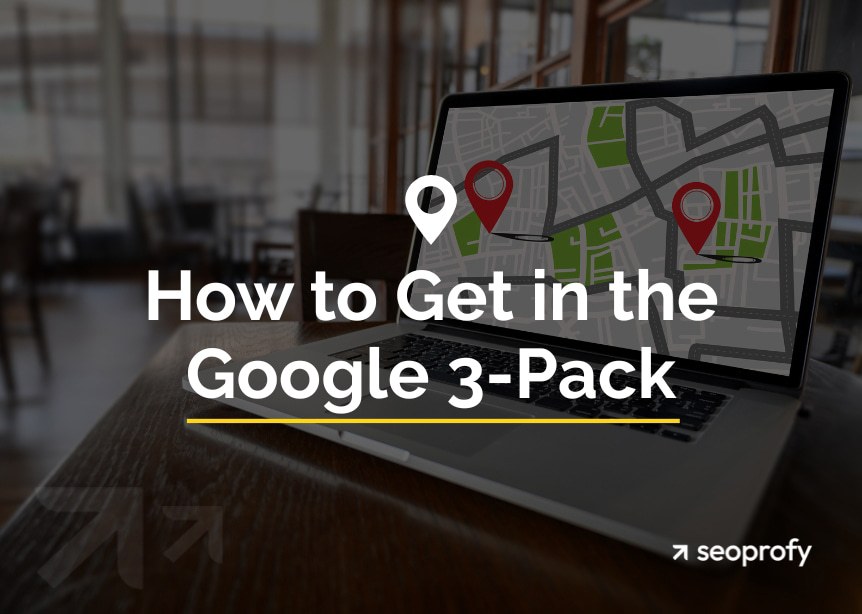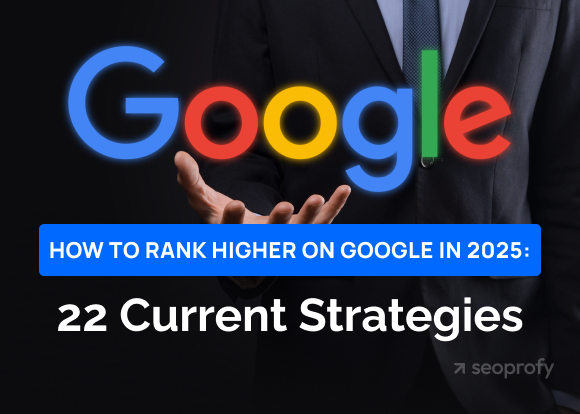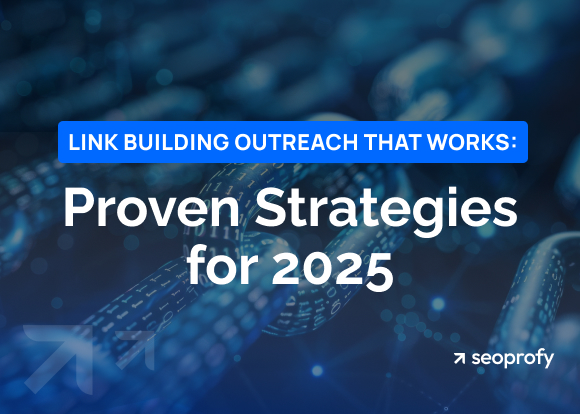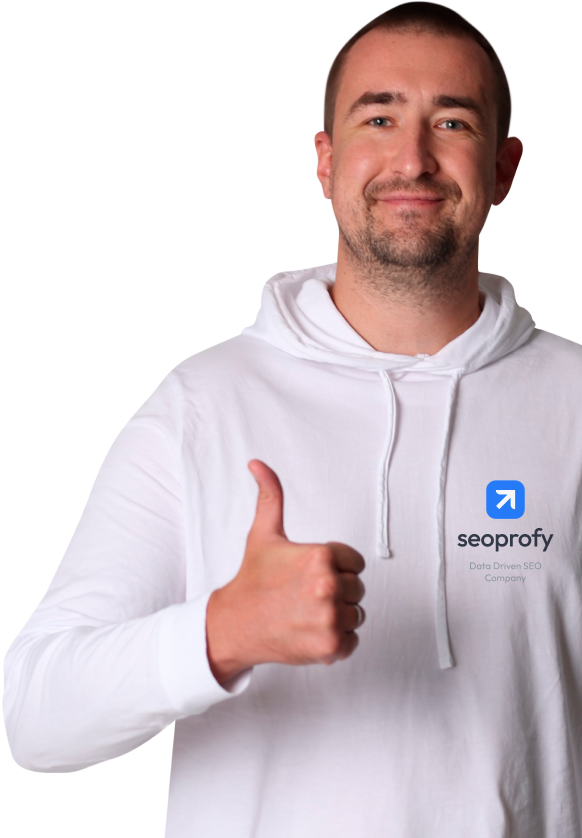Influencers might set trends and promote brands, but your website is the place where the actual purchases happen. If it doesn’t appear when customers search on Google, your products may as well not exist. SEO for the beauty industry is now a survival tool.
In the US, beauty care items consistently appear among the top online shopping choices across demographics. The opportunity is massive if your site is optimized to catch it. This guide walks you through long-term SEO strategies that help beauty websites attract, convert, and retain more buyers organically.
- SEO for beauty industry websites starts with a deep understanding of your audience and how they search.
- Studying how other beauty brands earn traffic and trust helps you spot weak points you can outperform.
- Content in the beauty niche should align with clear user intent, not just keywords.
- Technical and on-page optimization amplify the results of your entire SEO strategy.
Understand Your Audience & Market
Any effective beauty SEO (search engine optimization) strategy starts with one essential step: research. Before any keyword mapping, content planning, or link building, you need a clear understanding of who your potential customers are and how they search.
This initial research stage defines everything that follows, from site structure to conversion paths. In the following sections, we’ll walk through the practical steps to analyze your target audience, assess the market and ecommerce SEO trends, and collect the data that will guide your SEO decisions.
Define Buyer Personas
One of the most practical SEO tips for the beauty industry is also the simplest:
To create content that ranks and converts, you need to understand who you’re talking to.
Buyer personas help you move beyond generic beauty marketing to address real problems, preferences, and behavior. In beauty SEO, this means aligning your site with the routines, goals, and skin concerns of actual users, not just search terms.
Start with Google Analytics 4. Go to the User section to identify age groups, gender, devices, and locations of your visitors. Filter by traffic sources to see which platforms drive which types of users.
Next, open Meta Audience Insights (via Facebook Ads Manager). Enter relevant interests like “skincare” or “clean beauty” to get valuable insights into relationship status, job titles, hobbies, and online behavior.
When you know who’s buying, figure out why. Use tools like:
- Reddit (search subreddits like r/SkincareAddiction) to see what problems people talk about and what products they recommend
- TikTok search bar to find trending terms and complaints from users in your target age range
- SparkToro to uncover what social media influencers and media your audience follows.
With this kind of research, you can do more than define your buyer personas. You can also uncover market gaps that your brand is uniquely positioned to fill.
Fenty Beauty by Rihanna is a strong example. The brand identified a lack of inclusive makeup options and focused on underserved consumers, especially women of color who had been overlooked by mainstream competitors.
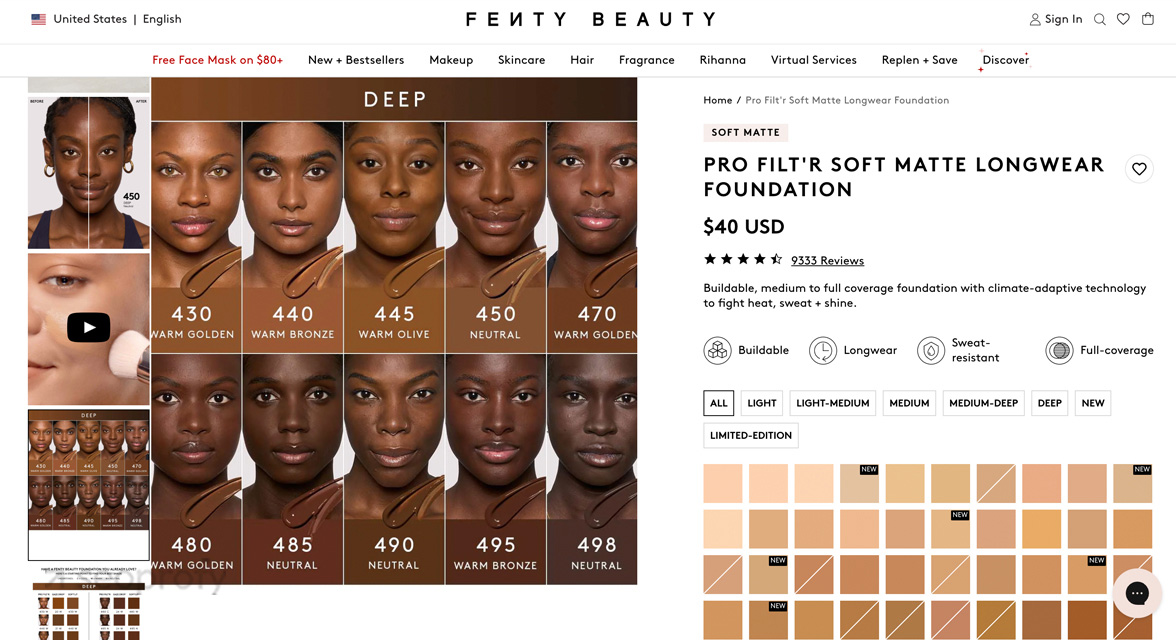
Rhode Skin by Hailey Bieber took a different approach. They spotted the rising popularity of the clean aesthetic in the beauty community and moved fast to meet the demand. The team defined their buyer personas as Gen Z and younger millennials who resonate with this trend. These consumers value minimalistic branding, transparent ingredients, and affordable pricing — all of which Rhode built into their product line and messaging from the start.
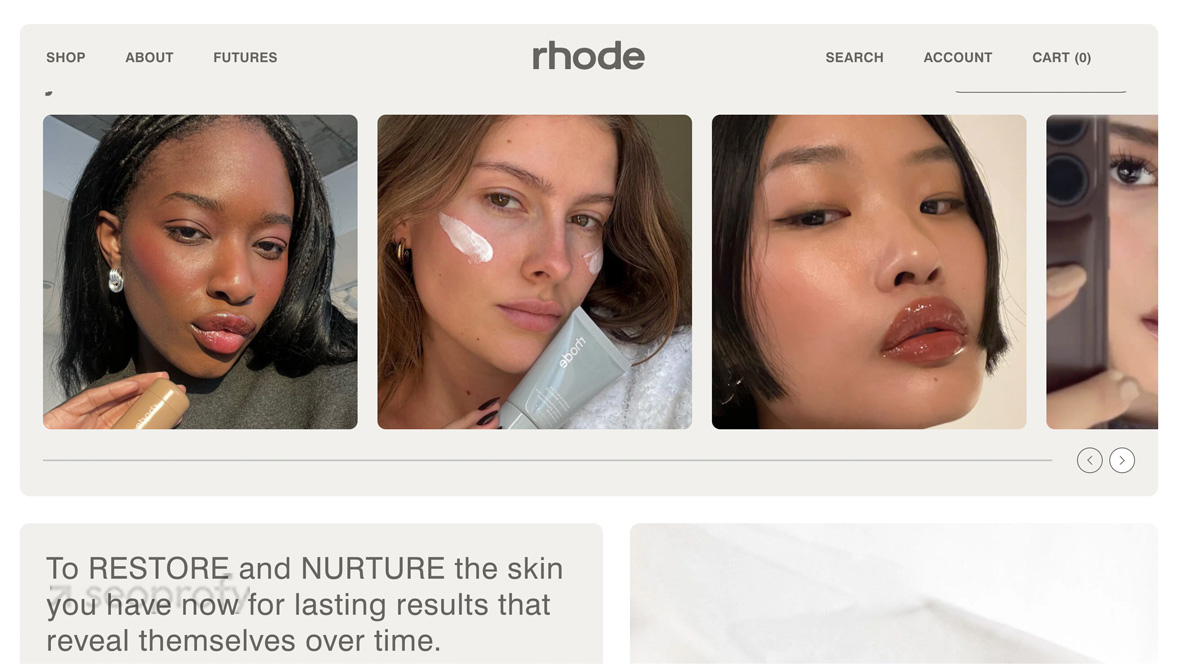
Once you’ve gathered all the input with tools, build personas that include:
- Skin concerns (acne, dryness, aging, etc.)
- Buying habits (price-sensitive vs. premium, research-heavy vs. impulse buyers)
- Content preferences (how-to videos, expert blogs, product reviews).
These personas will shape your keyword selection, site structure, and content tone. Skip this step, and your SEO strategy for beauty products risks targeting the wrong people with the wrong message.
Analyze Competitor SEO
Once your buyer personas are defined, the next step is to understand who already owns the organic space they’re searching in. Competitor analysis helps you benchmark against top-performing beauty brands and uncover gaps your site can fill.
Start by identifying three to five key competitors. You can find them by Googling your main product categories and seeing who consistently ranks at the top of the search engine results pages. Then plug their domains into the best SEO tools, like Semrush or Ahrefs, to begin analysis.
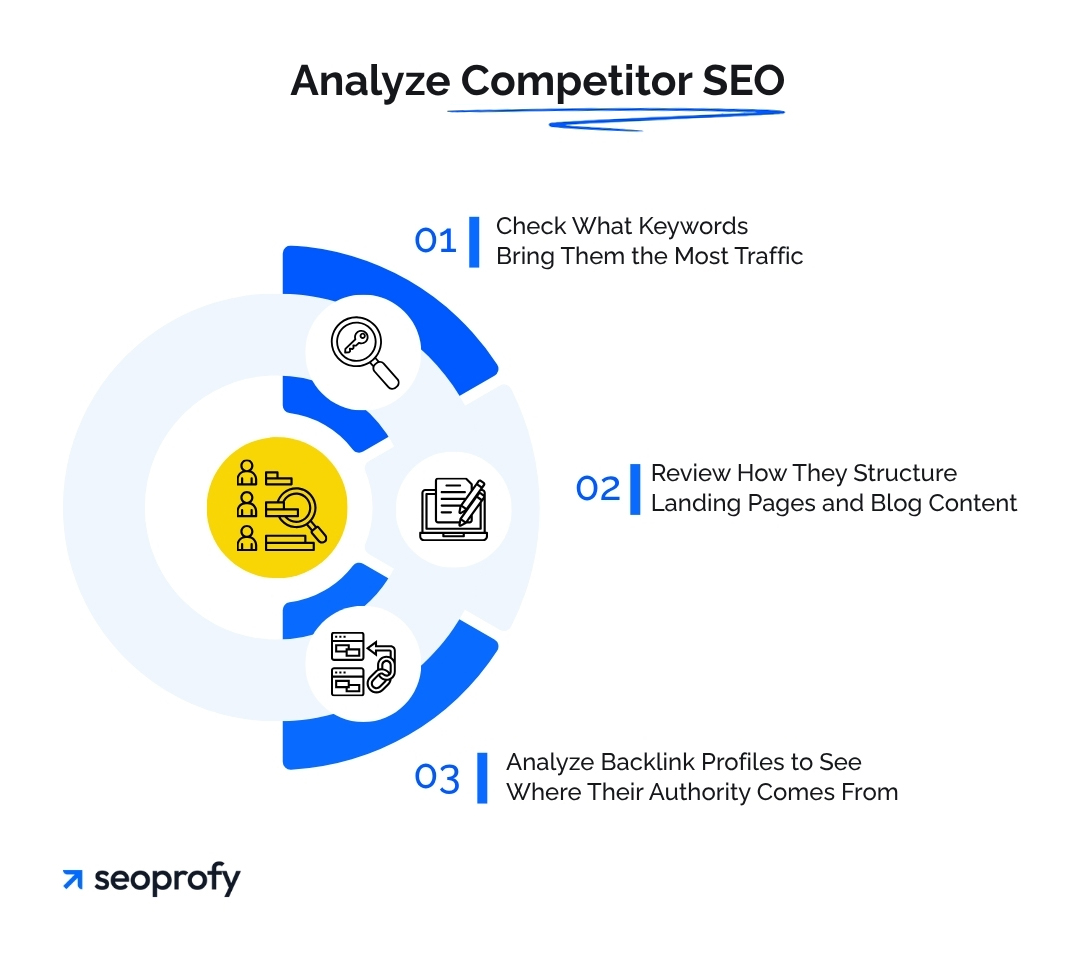
Check What Keywords Bring Them the Most Traffic
Open the Organic Research report in Semrush and enter the competitor domain. Then click the Positions tab to see which keywords drive traffic and which pages rank in Google. It also shows each keyword’s position, target URL, search volume, estimated traffic, and difficulty.
For example, a quick check of rhodeskin.com shows that most traffic comes from branded keywords like “rhode” and “rhode beauty.” The site ranks first for over 85,000 terms, which indicates strong brand awareness and a high share of direct search interest.
They also rely heavily on paid traffic, mostly through branded keywords. However, according to our SEO ROI statistics, 70% of marketers say SEO brings in more sales than paid ads.
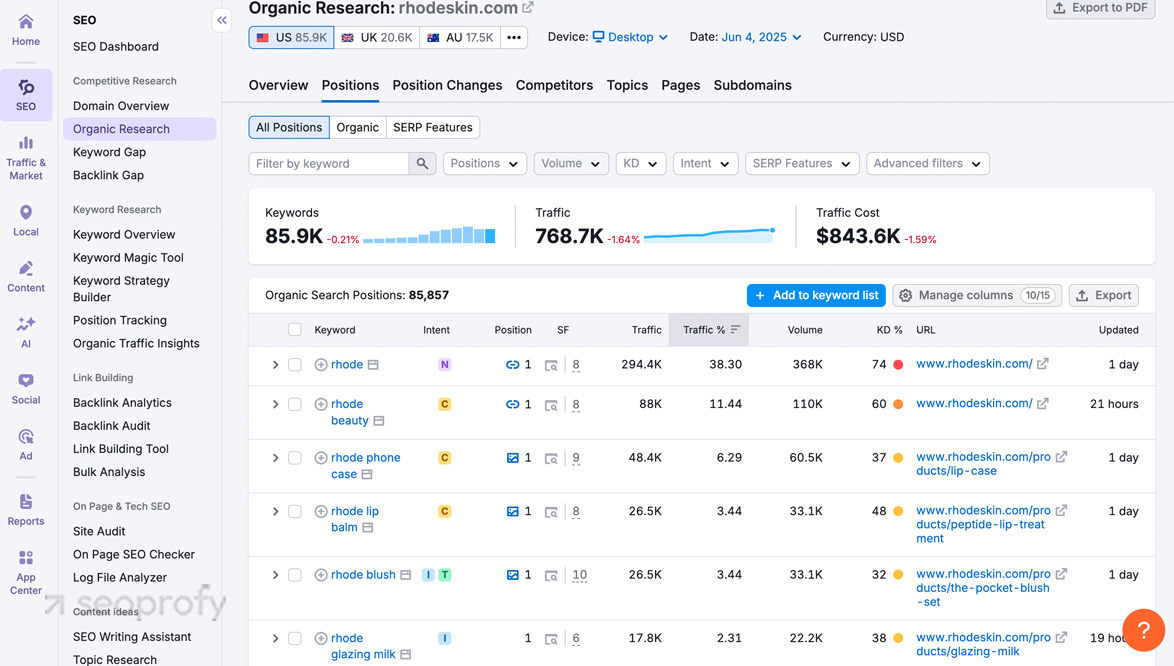
When analyzing, pay close attention to commercial vs. informational keywords. If a competitor ranks well for “best moisturizer for dry skin,” look at how they combine product pages with long-form guides or reviews.
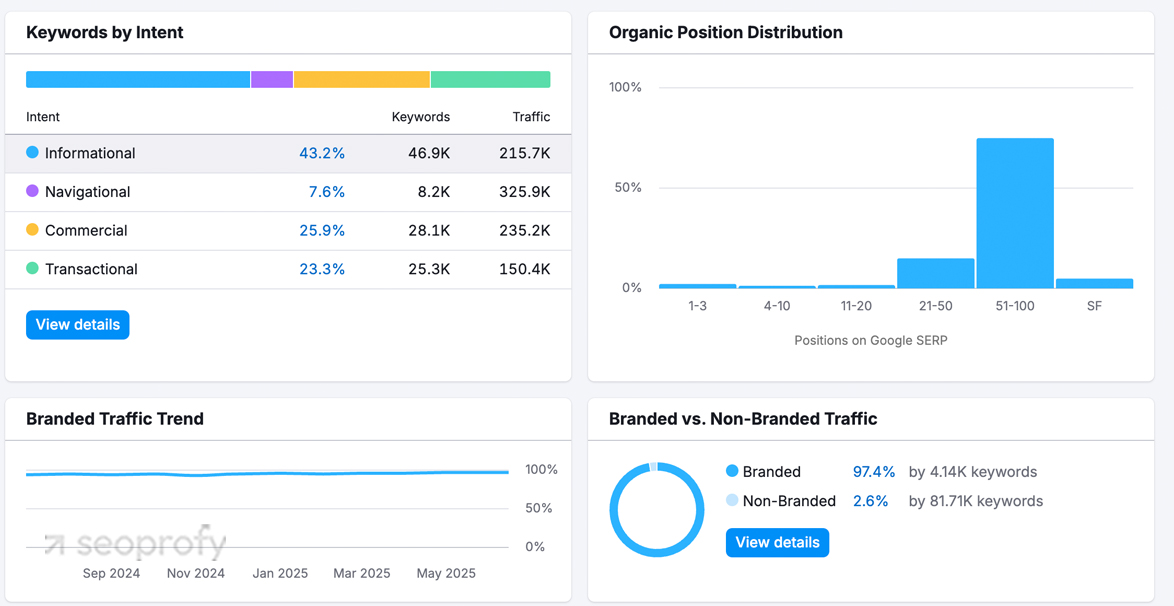
Review How They Structure Landing Pages and Blog Content
Manually browse their top-ranking pages and note how they organize content, use visuals, place CTAs, and build internal links. To illustrate the process, here’s a quick side-by-side look at Rhode and L’Oréal’s websites.
Rhode uses a video-based blog with no text except headlines. It feels more like a branded media page than a classic blog. L’Oréal publishes traditional text-based articles, grouped into clear subcategories like skin care and hair care. This makes browsing easier and improves topical organization.
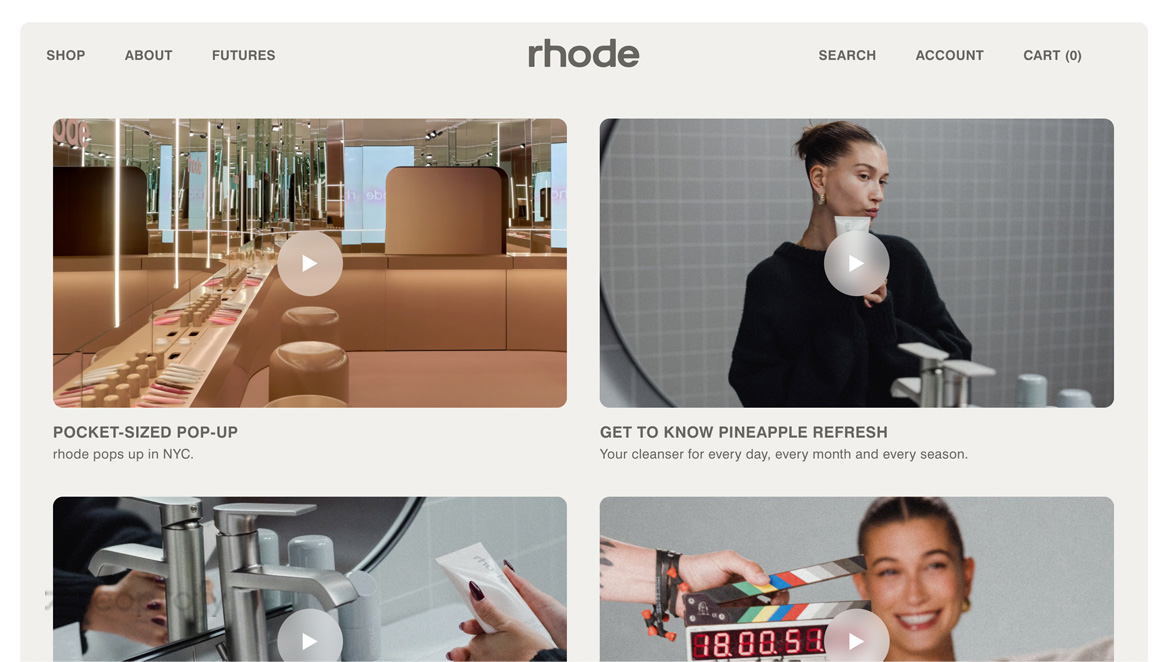
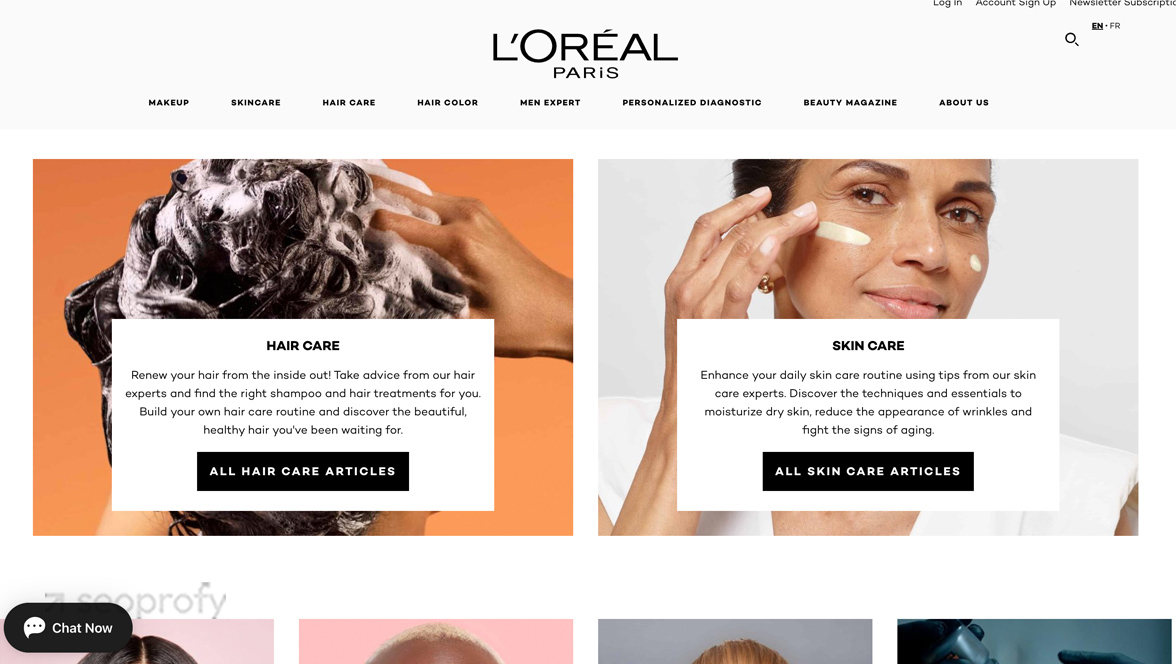
L’Oréal integrates product links directly into blog content. For example, in an article about scalp buildup, they link to their shampoo and conditioner. Rhode does not add links to products inside blog descriptions. Instead, they rely on internal linking through FAQs and the footer.
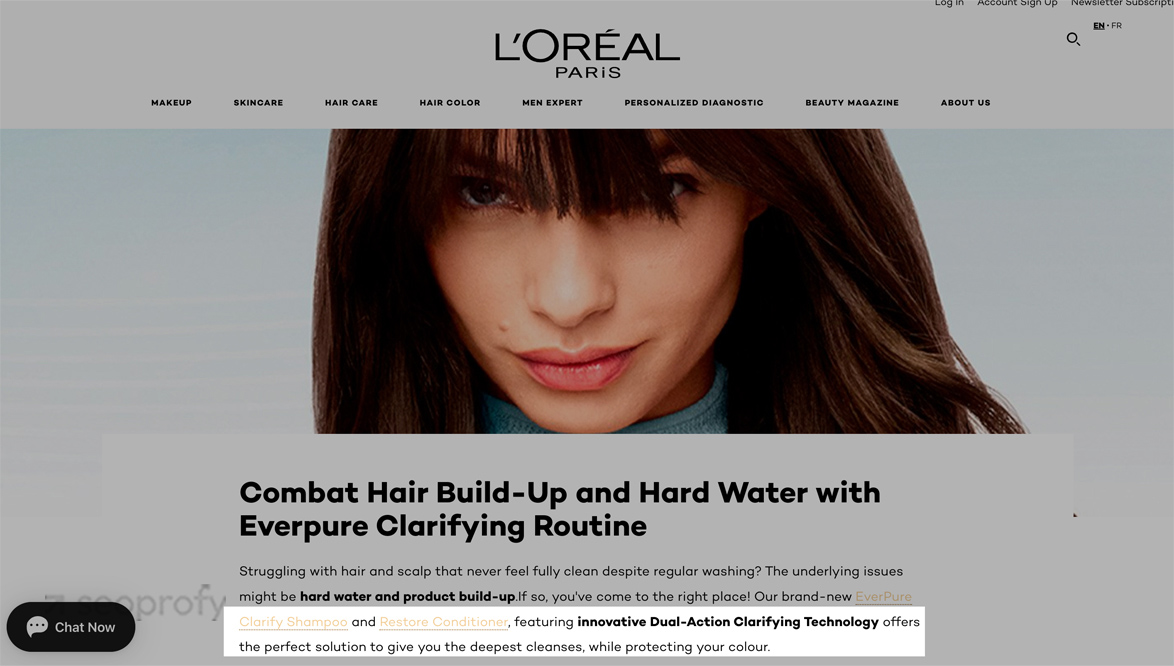
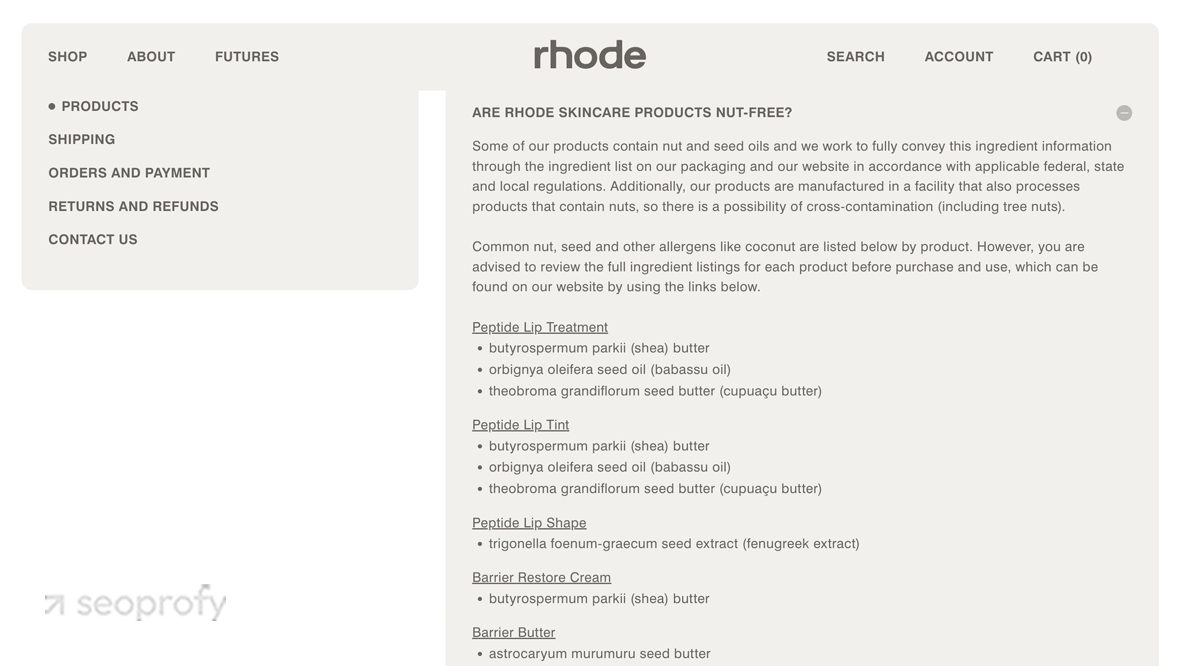
We can also compare how both brands handle calls to action. On Rhode’s site, users can add products to the cart right from the category grid, which shortens the path to purchase. L’Oréal uses View Product buttons that open full product pages first, adding an extra step but offering more information.
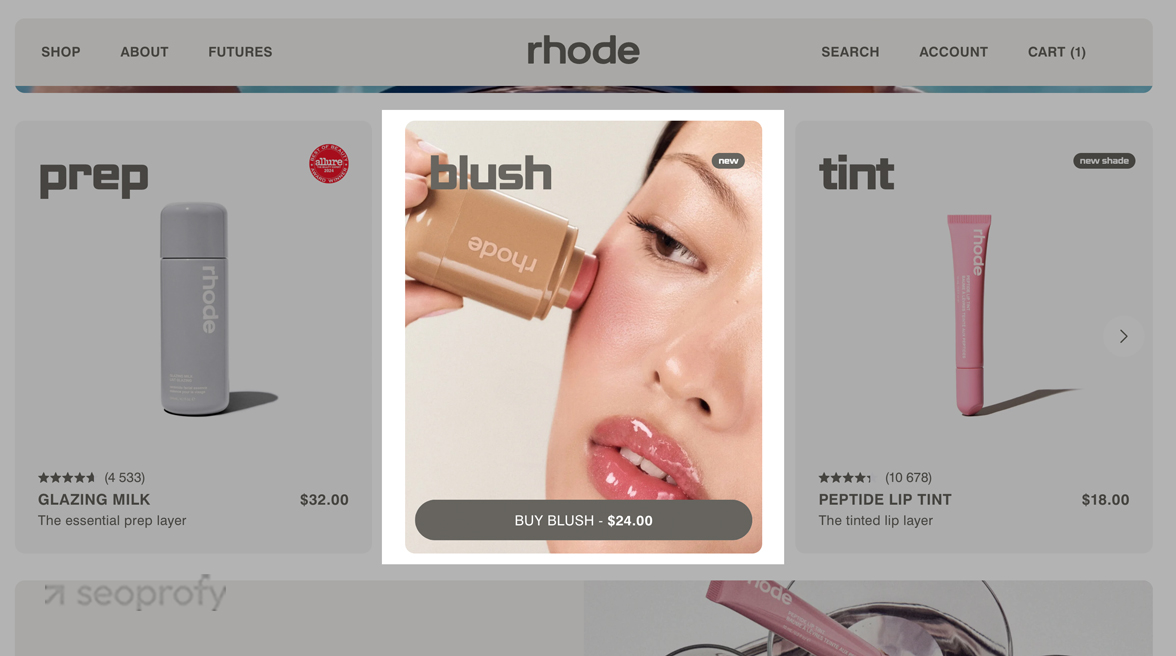
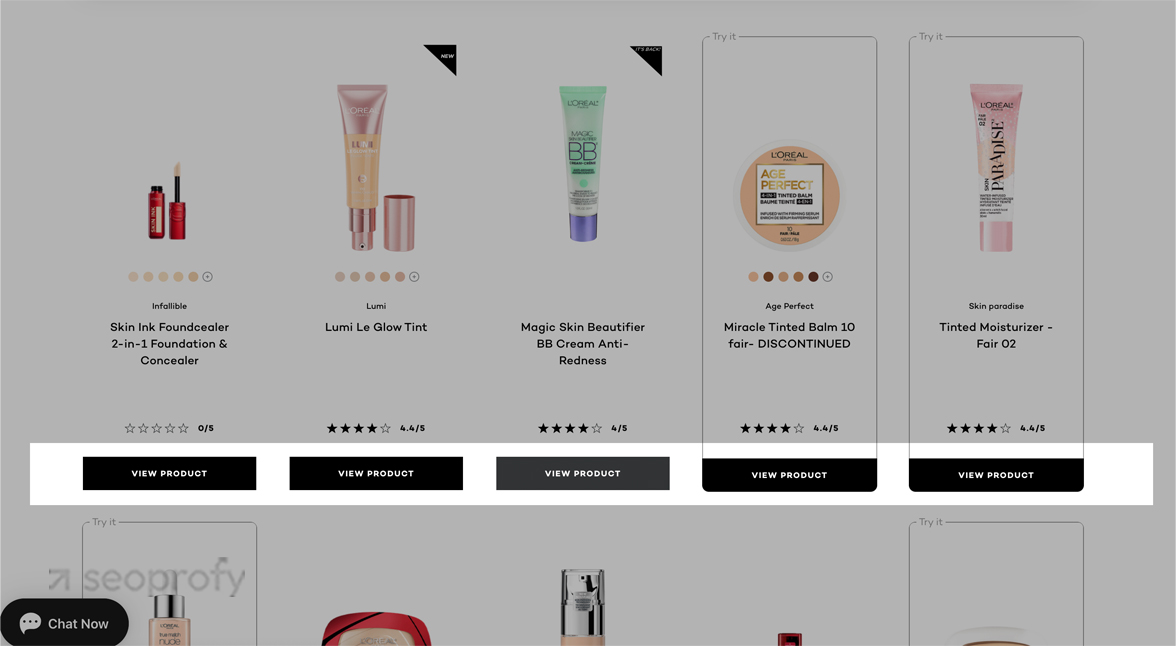
Analyze Backlink Profiles to See Where Their Authority Comes From
In Ahref’s Backlinks or Referring Domains section (or in Semrush’s Backlink Analytics), review which pages get the most links and from which types of websites (media, forums, niche blogs).
Take a look at these snapshots from Sephora’s backlink profile. In the Backlinks tab, we see new links from high-traffic sites like thepennyhoarder.com and nymag.com. These links are placed inside editorial content and point to specific product or profile pages, using relevant anchors like “Beauty Insiders” or product names.
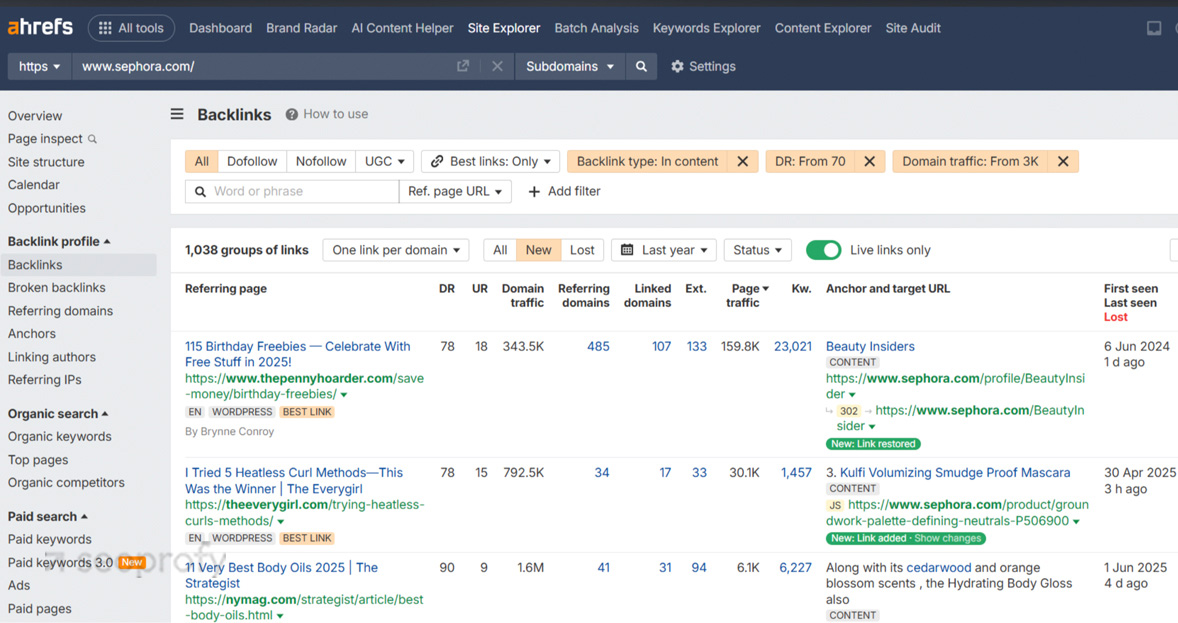
In the Referring Domains tab, we see top-tier sites like cnn.com, bbc.com, and taboola.com. These domains have DR over 90 and may send thousands of monthly visits.
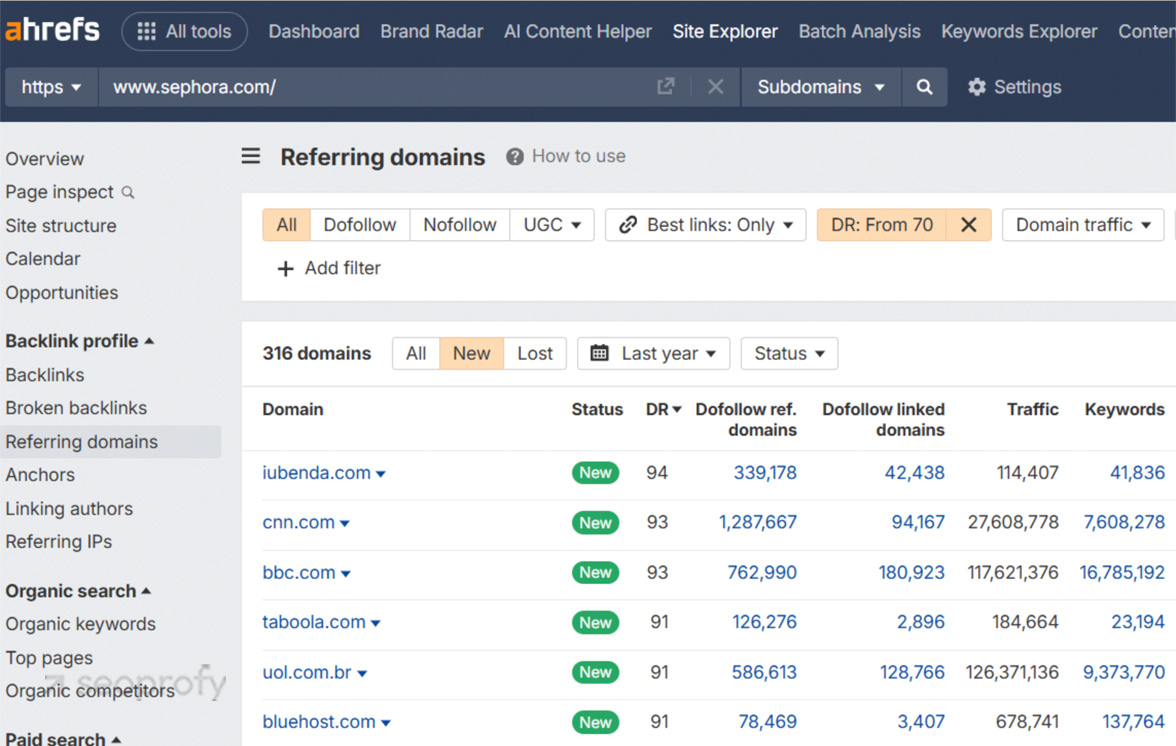
On top of that, you can also use Similarweb or BuiltWith to understand traffic sources and on-site tech. Combine this with a manual audit of UX, design, and conversion flow to spot what they do better.
This kind of SEO intelligence helps you position your brand strategically, not by copying, but by identifying where competitors are strong, where they’re weak, and how you can do it better.
At SeoProfy, we’ll audit your beauty site, fix technical gaps, and align your content with real search demand. This gives your brand:
- Growth in non-branded traffic
- Better positions in Google for commercial queries
- Higher engagement and sales
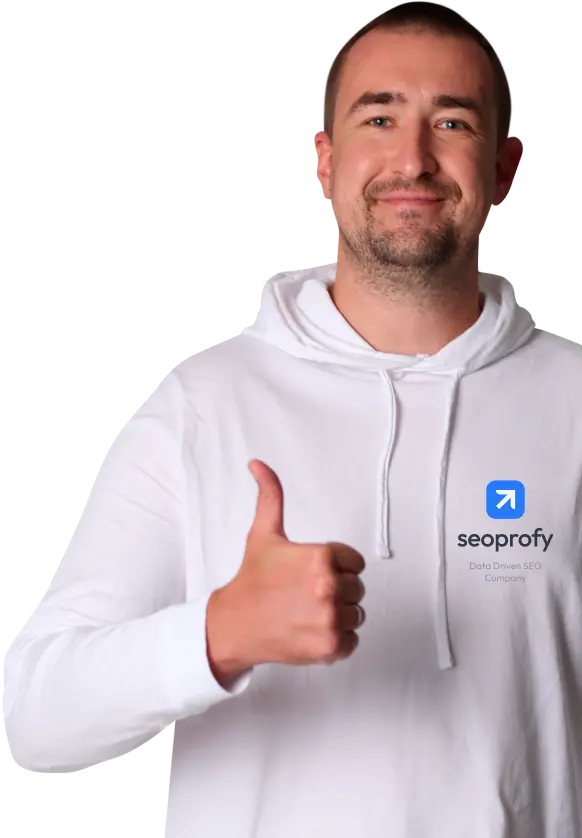
Build a Keyword-Based Content Strategy
When you know who your audience is and how competitors are attracting traffic, it’s time to build your own strategy. At the core of SEO for the beauty industry is content that matches search demand. Beauty keyword research ensures you’re not guessing what to write but targeting real queries from real people.
Keyword Research in the Beauty Niche
Let’s start by building a list of relevant keywords you want to rank for. You need to understand what your audience is searching for at different stages of their journey. This includes everything from identifying a skin concern to comparing or buying specific products.
- Google Search Console: If your site already gets some traffic, go to the Performance section and open the Queries tab. You’ll see what keywords are already bringing impressions or clicks, including unexpected ones you might not be targeting yet.
- AlsoAsked and Answer the Public: These tools help you pull real questions from users. Use them to capture traffic from problem-driven searches like “how to fix oily skin” or “what order to apply skincare products.”
- TikTok and YouTube autocomplete: These platforms are great for spotting beauty trends early, especially among younger users. Try typing in general terms like “acne routine” or “summer makeup” and see what suggestions come up.
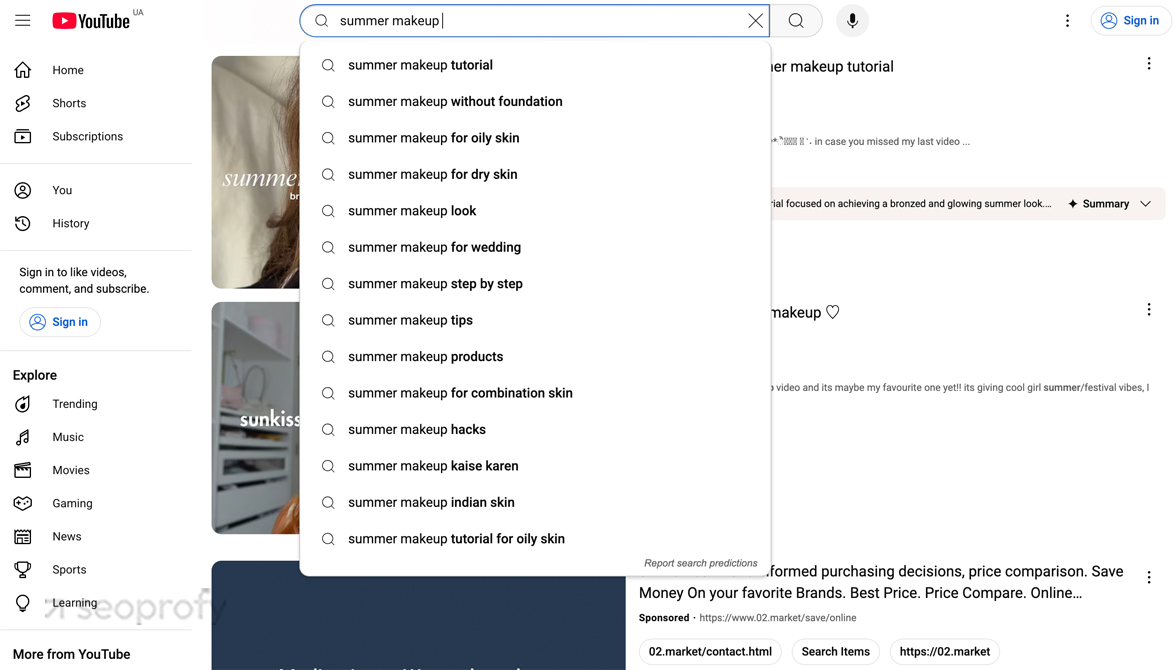
- Ahrefs or Semrush: This is where the competitor analysis you already did comes in handy. Now go deeper. Check the intent, keyword difficulty (KD), search volume, and traffic potential of the queries your competitors rank for. A high KD means tougher competition, while long-tail keywords often bring smaller but more targeted traffic. The Matching Terms report can help you find related phrases, expand your beauty keyword list, and uncover underserved topic areas.
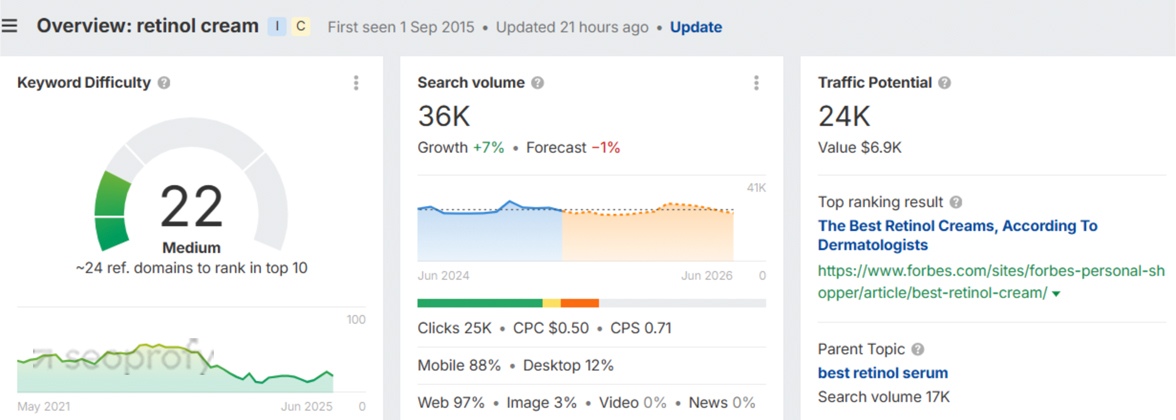
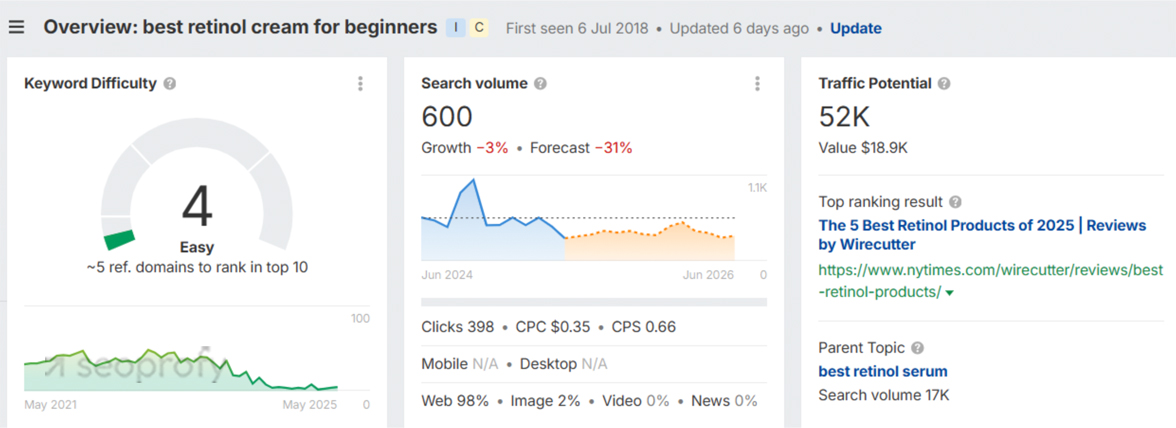
Many beauty brands overlook regional phrasing. For instance, users in the US search for “acne spot treatment”, while in the UK it may be more common to say “blemish treatment.” Same intent, different wording. Use the country filter in your chosen tool to make sure your keywords match local search behavior.
Once your list is ready, group keywords by intent: informational, commercial, and transactional. Ahrefs uses color-coded tags to help with this. Intent defines the funnel stage and expected content format.
For example, “what causes breakouts” calls for an educational blog post. “Best cruelty-free mascara” suits a product roundup. “Buy retinol serum” should go straight to a product page.
Match your content type to what users want at each stage to move them closer to a purchase. Here’s how La Roche-Posay approaches it: they use blog articles to target informational queries and send transactional keywords directly to optimized product pages.
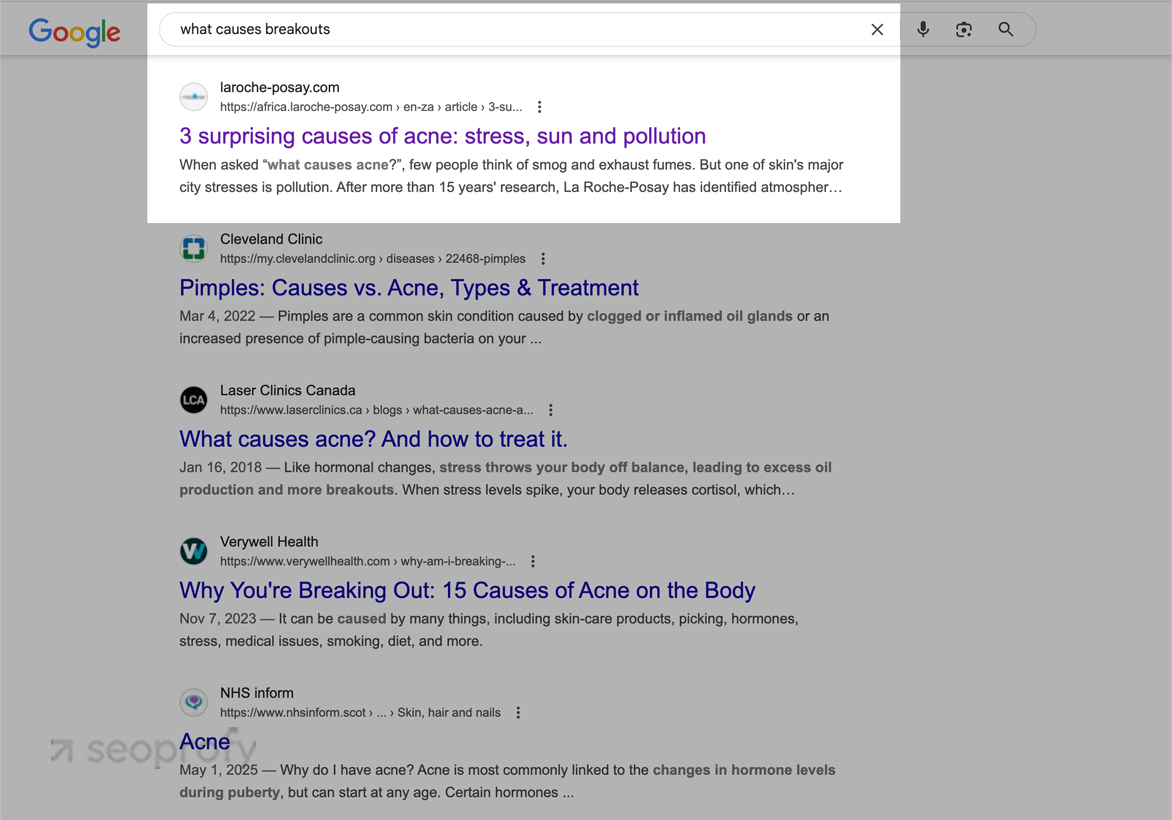
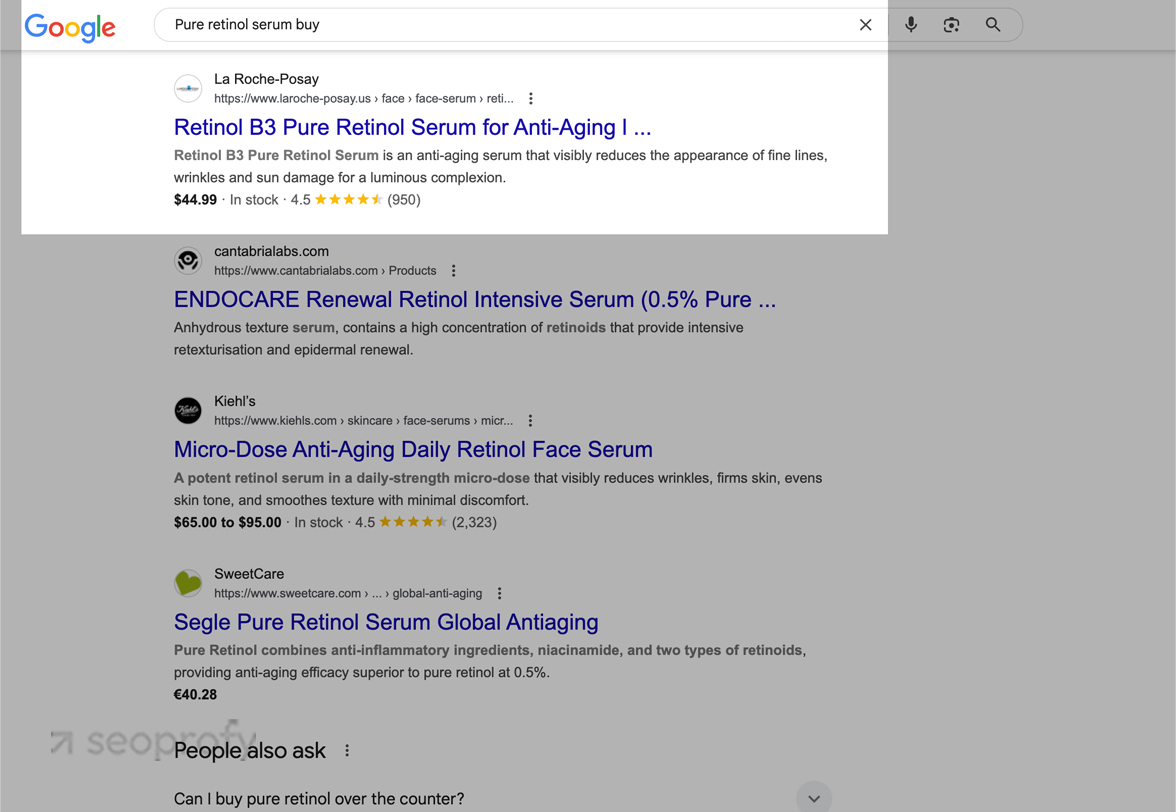
Create Content Pillars & Clusters
The next step in building your SEO campaign is to organize it into content pillars and clusters. Start with broad, high-level topics like “skincare,” “makeup,” or “haircare.” These serve as your pillar pages and content categories. Around each one, create supporting content that targets long-tail and related queries, such as “how to layer skincare products” or “best foundation for dry skin.”
Internally link cluster articles back to the main pillar and between each other when relevant. This structure helps users navigate your site more easily and signals topical authority to search engines.
A strong example of well-structured internal linking is the blog from La Roche-Posay. In their article “Why is sunscreen important? How to minimize the risks of developing skin cancer,” they strategically link to other pieces with different intent:
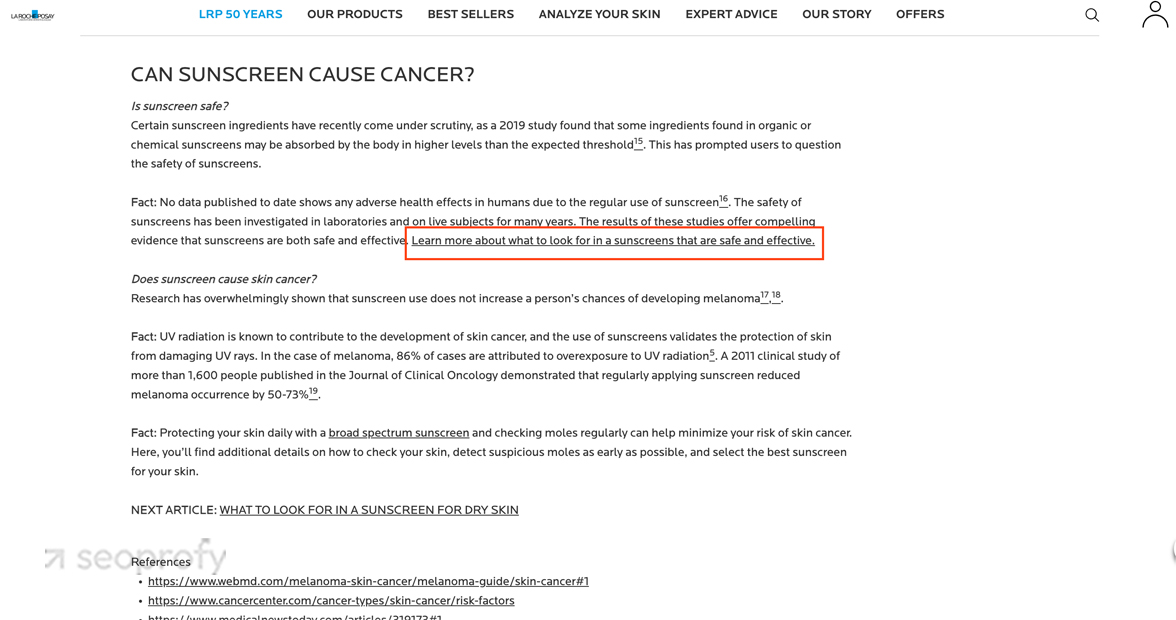
These include “Sun protection & sun safety tips for adults & kids” for additional education, and “UVA vs. UVB rays and finding the best sunscreen for you,” which pushes users closer to product selection and purchase. Clear structure, strong internal linking, and intentional keyword use all work together to improve rankings and topical relevance.
Sometimes, all it takes is a fresh set of expert eyes. In our SEO case studies, we often break down how we approach content quality evaluation and uncover missed opportunities to strengthen performance.
Optimize Your Website for Search Engines
You can build the smartest keyword and content marketing strategy out there, but what’s the point if Google can’t crawl or trust your pages? That’s why technical and on-page optimization matter just as much as the content itself.
For SEO for beauty brands to work, your site has to be fast, structured, mobile-friendly, and easy for search engines to understand. Let’s go over the key areas to focus on if you want your site to be search-friendly and competitive.
Technical SEO for Beauty Sites
Google prioritizes fast sites with a mobile-first approach. Start by testing your website with PageSpeed Insights and Core Web Vitals reports. To speed up the loading, consider reducing unused scripts and compressing large images.
As a quick test, we ran Sephora’s mobile site through PageSpeed Insights and found that it failed the Core Web Vitals assessment due to a high Interaction to Next Paint score:
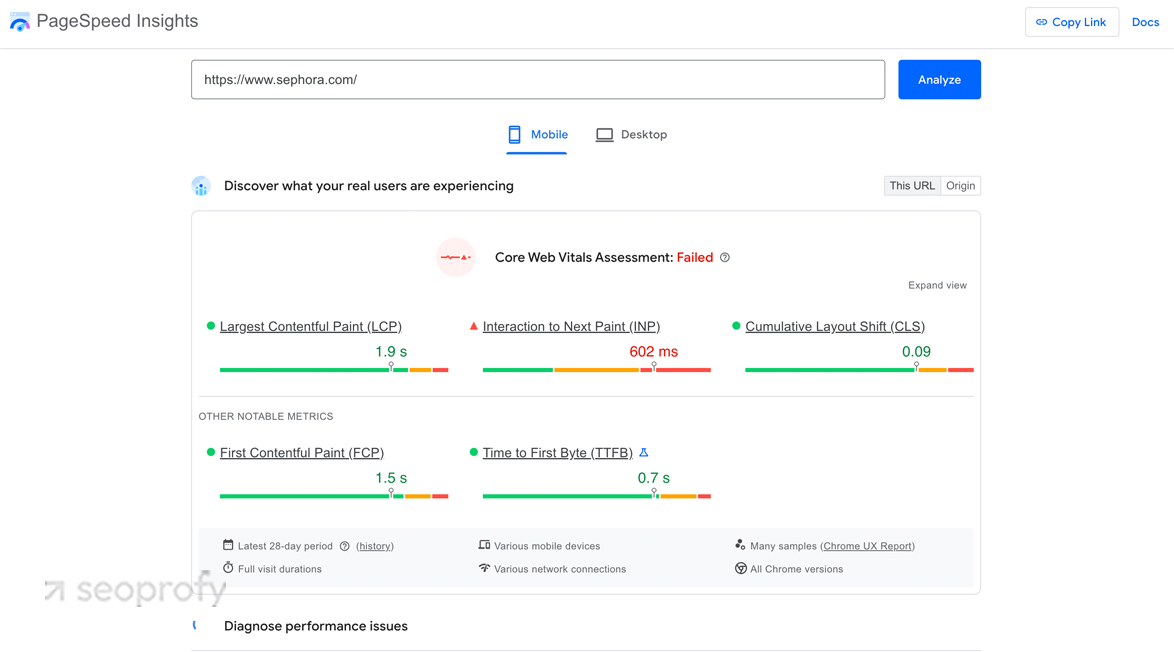
Your mobile usability and performance must be your first technical priorities. More than 60% of all Google searches across industries happen on mobile devices. In beauty, where consumers often use voice search and buy on the go or while browsing products on social media, this percentage is likely even higher. On top of that, after Google’s latest update, the search engine now primarily uses the mobile version of a site for crawling and ranking.
Next, add structured data with schema.org markup. Product description pages should include Product schema with price, availability, and reviews:
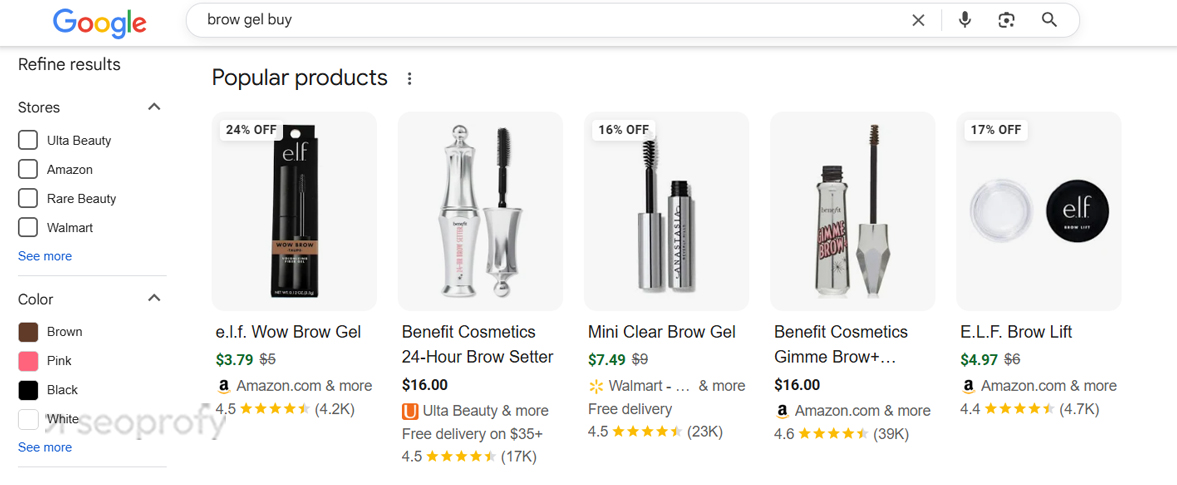
FAQ schema helps your answers appear directly in search results and improve visibility and click-through rates, which are one most important SEO benefits in the cosmetics industry.
To demonstrate how it works, we ran a test code snippet for a hypothetical beauty product page through the Schema Markup Validator and got the following results:
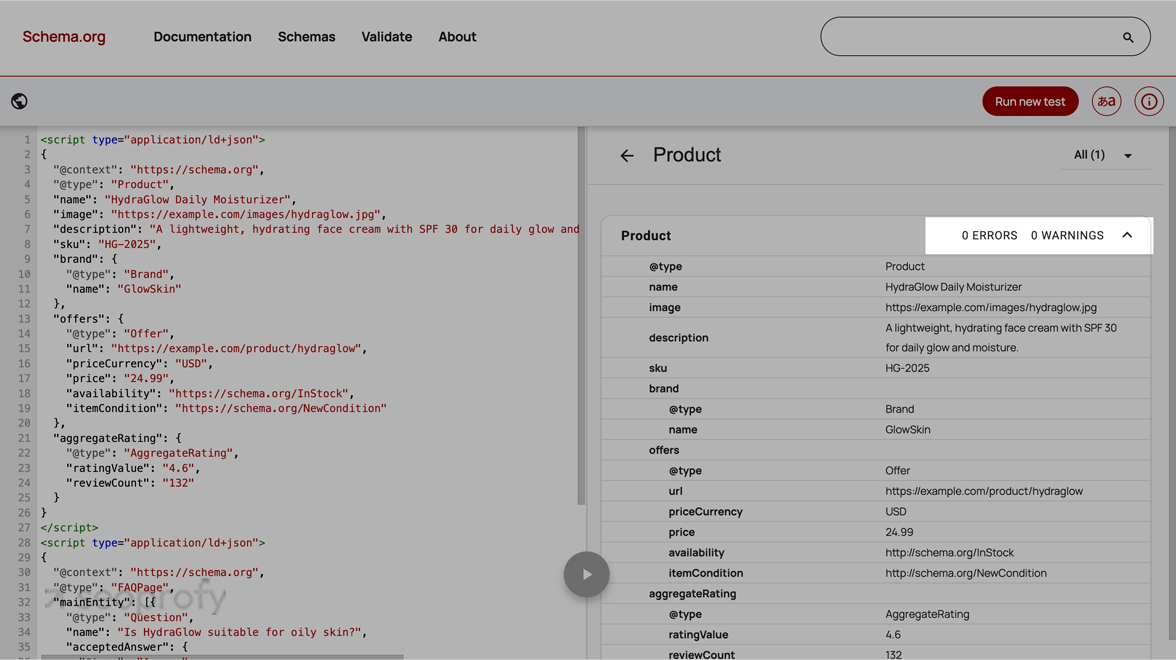
On-Page SEO for Product & Category Pages
Your product and category pages are often your highest-traffic entry points. Optimizing them helps both users and search engines understand what you offer.
Start with metadata. Your title tag should include the primary keyword and a value proposition. Example: “Hydrating Vitamin C Serum for Sensitive Skin.” Meta descriptions can improve CTR, so write them with intent: clear benefit, supporting keyword, and soft CTA.
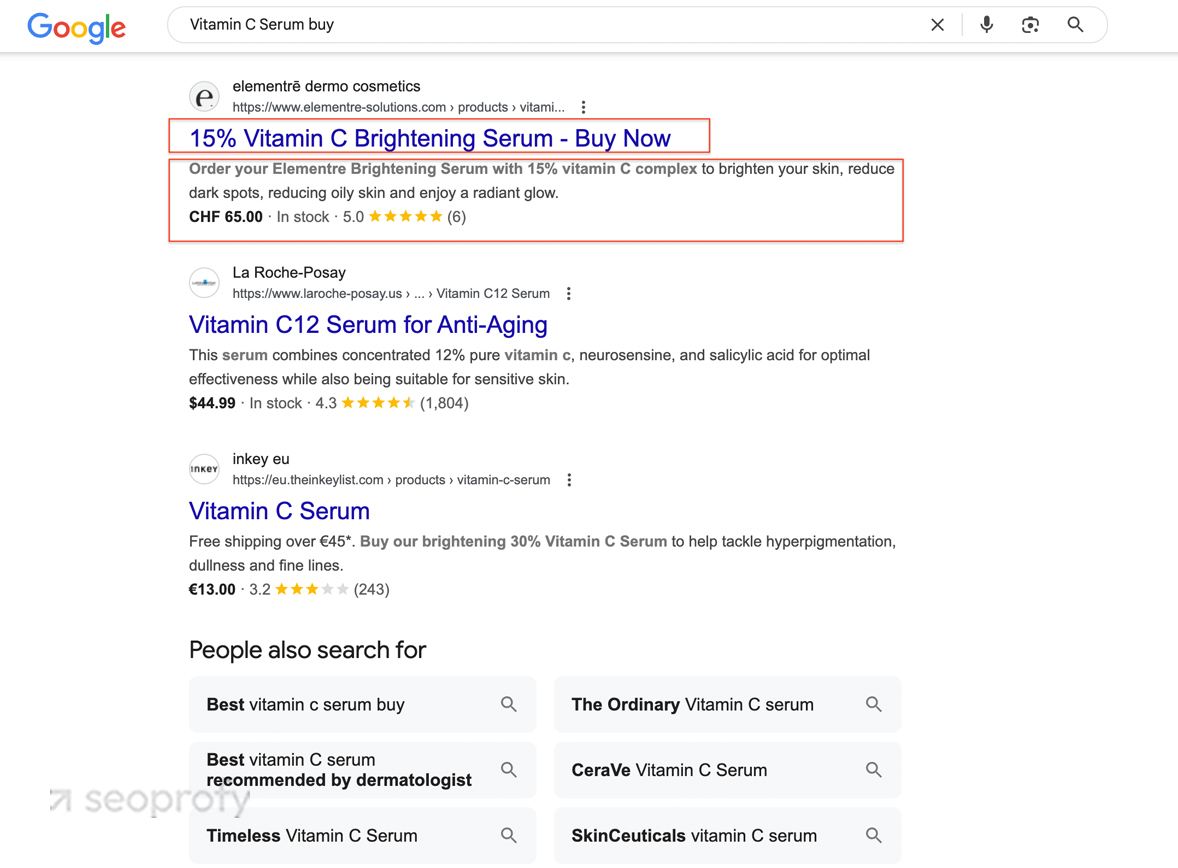
Next, focus on content structure:
- Use a single H1 per page that includes the core term.
- Support it with subheadings (H2 to H3) that match user search intent, such as benefits, ingredients, or how to use.
- Write unique, benefit-driven product descriptions. Don’t just list features. Explain how the product solves a problem (for example, “Reduces inflammation without drying out sensitive skin”).
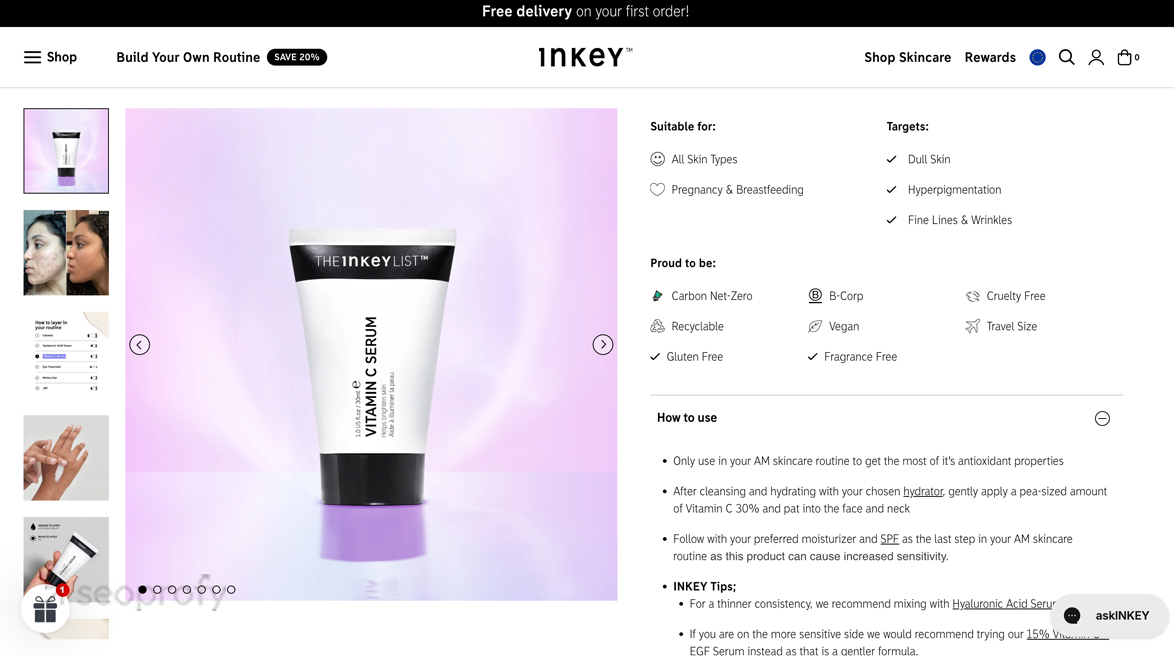
- Add alt text to every image, describing not only the product but context (such as “matte finish foundation on oily skin”).
Finally, avoid boilerplate content across similar items. Each page should be distinct and targeted. This is especially critical for large catalogs, where Google needs clear signals to differentiate similar SKUs.
Maximize Reach Through Off-Site SEO
Backlinks remain one of the strongest ranking signals in SEO for beauty products. But not all links carry equal weight. For an ecommerce content strategy to work and benefit your marketing campaigns, you need high-authority, contextually relevant links from trusted sources in the beauty niche.
Start by identifying where your audience already consumes content. This could include online magazines, comparison blogs, YouTube review channels, and influencer-owned platforms. Use Ahrefs’ Best by links and Linked domains reports on competitor sites to see which beauty publishers or creators regularly link out.

Here is an example: beautypackaging.com is a trusted site with strong authority and around 13.5K monthly traffic.
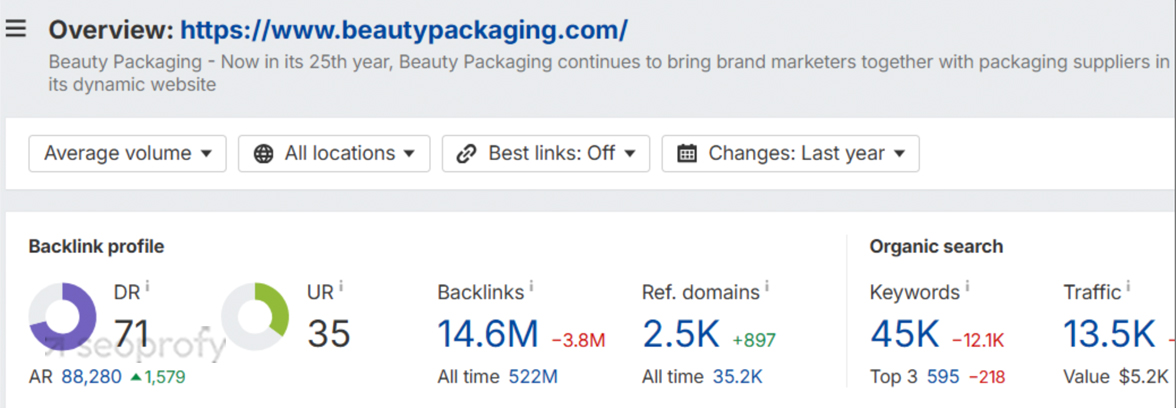
In the Linked Domains report, you can see that this website links to many beauty brands including Joelle, Coffee Bar, Arcade Beauty, and Apothia.
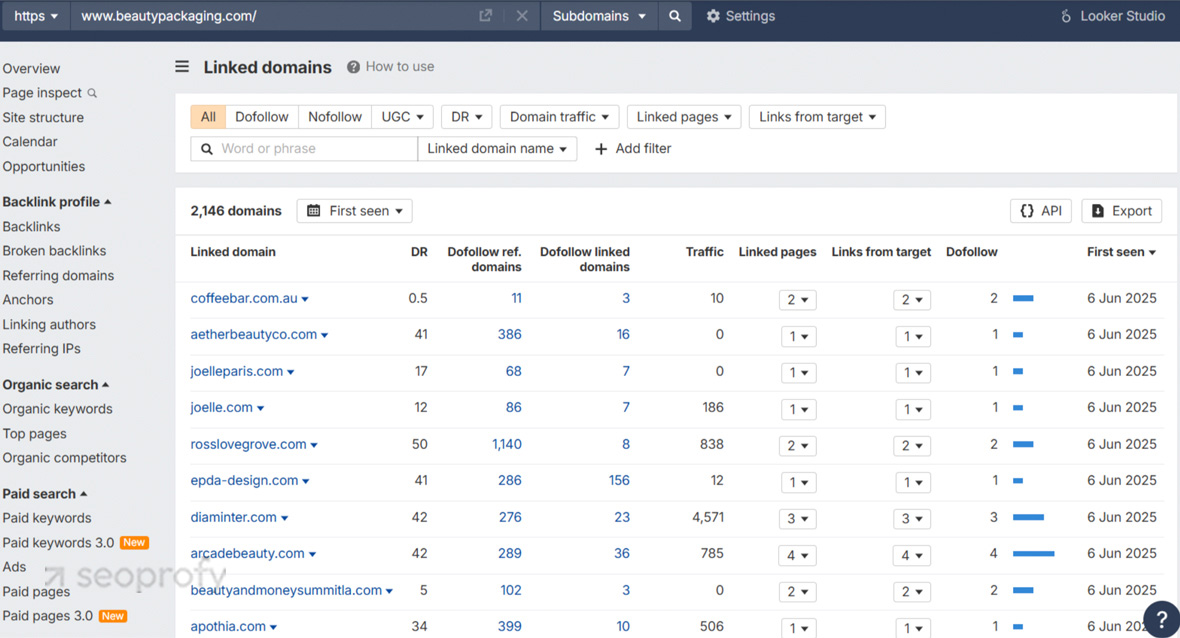
Here’s an example of one of these placements on their site. As you can see, they actively reference other beauty and skincare brands, which makes them a promising opportunity for outreach.
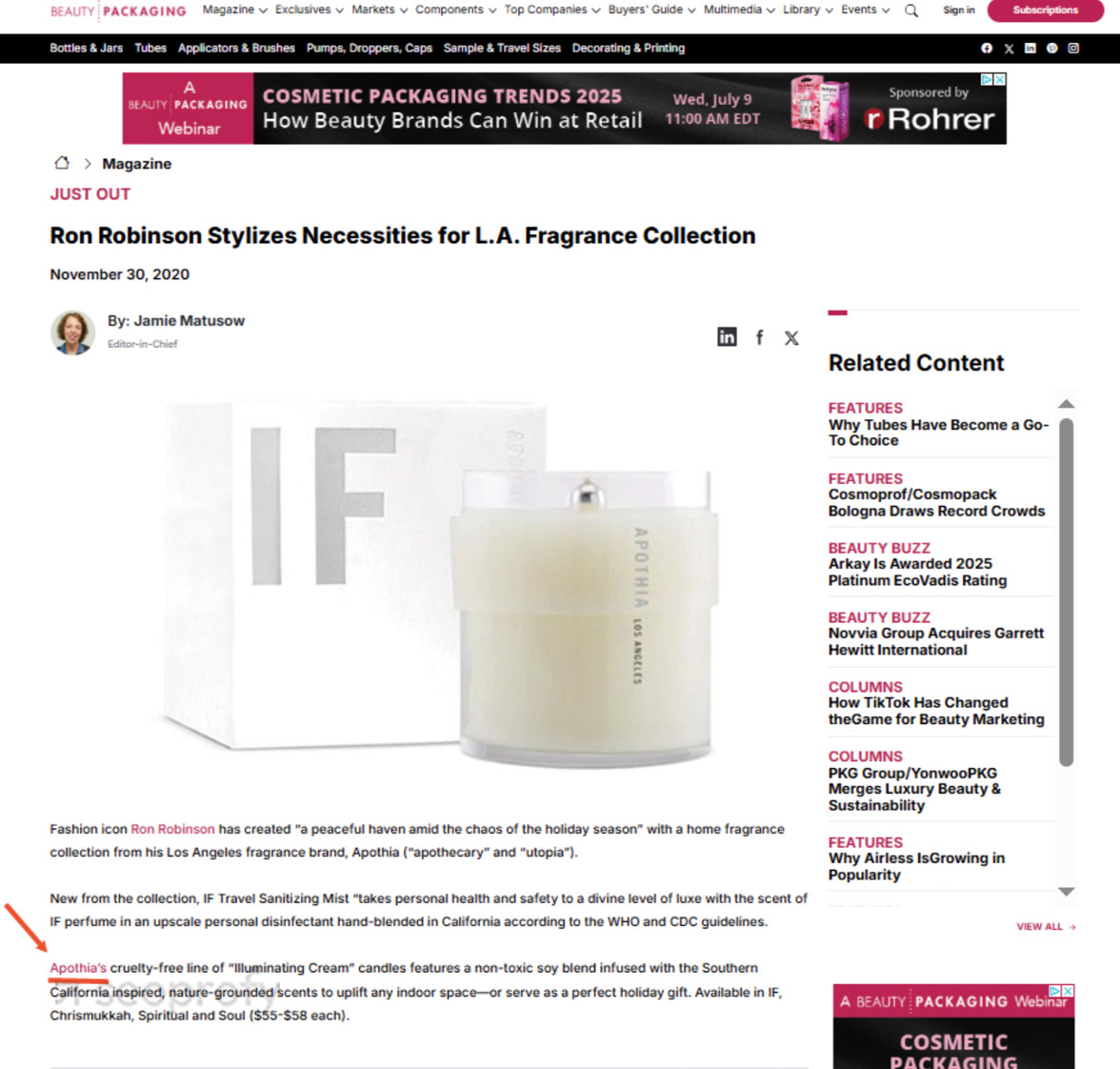
Also, you may want to pitch product samples to editors at popular sites like Allure, Into The Gloss, or Who What Wear with a clear angle. Present specific benefits of your solution that make it different from other products in its category.
For influencer outreach, skip mass DMs. Build a shortlist of micro-influencers (10k–100k followers) who rank high in audience engagement and credibility. Use SparkToro or Modash to find those whose followers overlap with your personas.
Negotiate links within sponsored content or gift-based collaborations. Example: a YouTube video titled “Best Tinted Sunscreens for Oily Skin” that includes a link in the description and/or a pinned comment. Google now follows many links from YouTube/Instagram/other social media platforms, especially when they appear alongside brand mentions in blog posts or affiliate reviews.
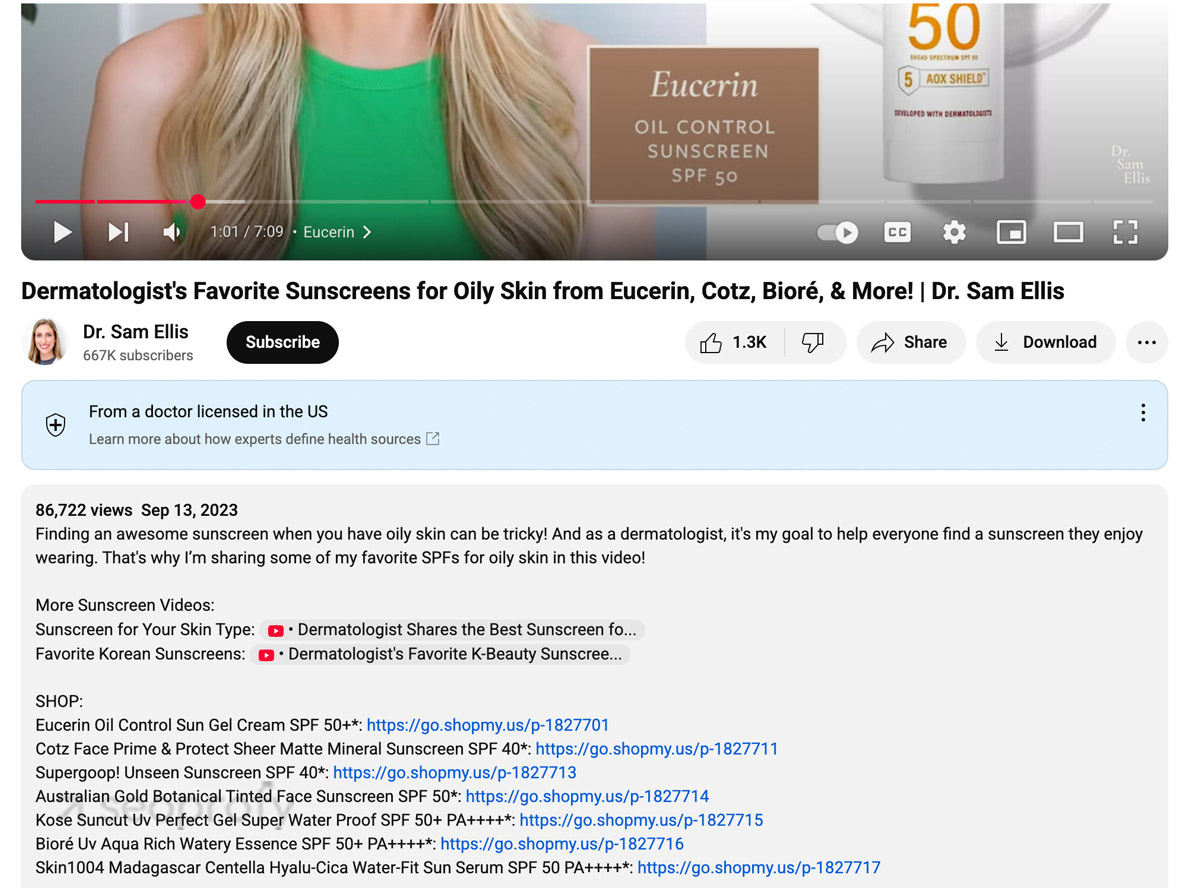
Avoid spammy tactics like link swaps or random guest posts. Focus instead on relationships that bring organic traffic and trust.
Quality always beats quantity.
Leverage User-Generated Content
In SEO for beauty websites, user-generated content (UGC) started as a low-cost way to build trust. Early on, brands encouraged existing customers to post reviews, demos, or beauty tutorials simply in exchange for a repost.
Today, many UGC creators are essentially small-scale beauty influencers. They offer paid or barter-based content that mimics organic posts but is carefully structured and negotiated. This type of UGC can be useful for beauty brands, especially when it fits the platform’s native style, but it’s not truly free or spontaneous.
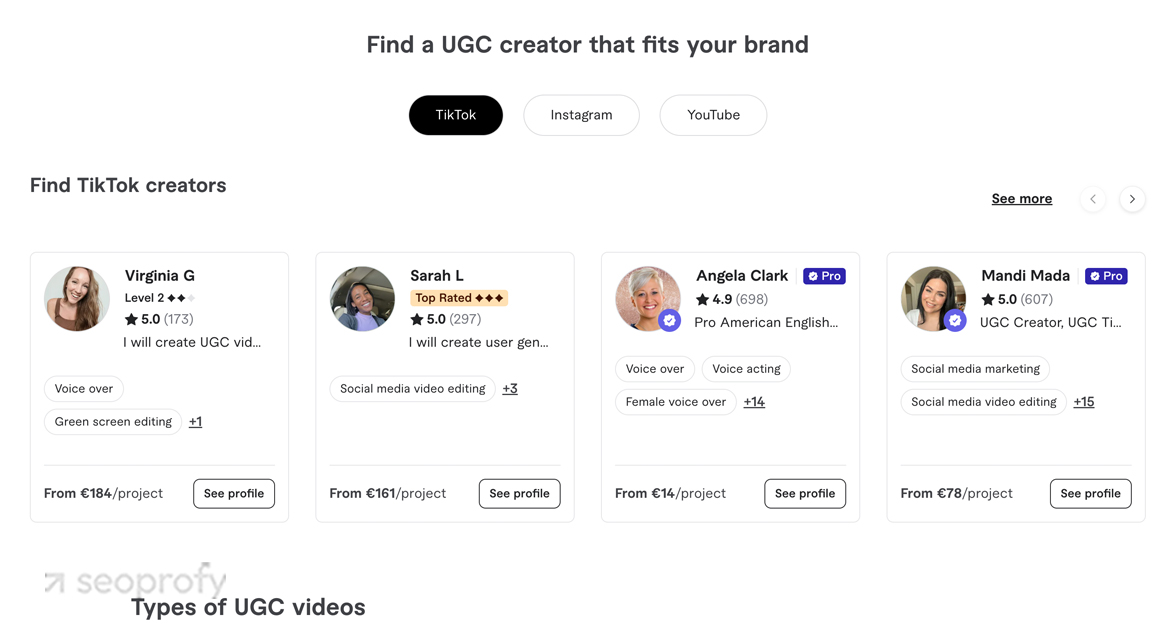
That said, authentic UGC still matters. Real reviews, tagged photos, and unprompted mentions create stronger social proof than scripted collaborations. Encourage these by running giveaways, featuring customer photos on product pages, and sending thank-you notes when users tag your brand.
Blogger outreach helps here too, since 74% of US shoppers tend to purchase a product after it’s been endorsed by an online influencer. A simple sample mailer to niche bloggers or skincare YouTubers can trigger honest, unpaid mentions that outperform paid ads in credibility. Focus on people who already love the category, even if they don’t call themselves influencers.
Measure Your SEO Performance & Adjust
You can’t improve what you don’t track. Measuring SEO performance helps you see what’s working, what’s wasting time, and where to focus next.
Start by connecting your main SEO tools, Google Search Console and GA4. Look at which queries are driving impressions and clicks. Then track what users do once they land. Do they convert, bounce, or browse?
Key reports to review regularly:
- Search Console: Queries, click-through rates, and average position
- GA4: Landing page performance, conversion events, assisted conversions
- Ahrefs or Semrush: Keyword movements, backlink growth, and website traffic estimates.
If certain pages rank well but don’t convert, check page speed, CTAs, or messaging. If blog content drives traffic but not sales, link to relevant products or improve funnel flow.
Performance tracking should be a continuous process in digital marketing. Review monthly, adjust quarterly, and document what changes impact performance. Alongside rankings and conversions, keep an eye on how much you’re investing. This is key to identifying whether your current approach qualifies as cost-effective SEO.
Make Your Beauty Website Rank Higher
SEO for beauty care products comes with unique challenges. The cosmetic industry is saturated and trend-driven. New ingredients, seasonal launches, and shifting user behavior can impact rankings overnight. To compete, you need a strategy grounded in data, flexible enough to evolve with the market, and SEO best practices for beauty brands for precise execution.
At SeoProfy, we’ve built strong frameworks for beauty and skincare companies of all sizes. Our ecommerce SEO services focus on brand visibility that brings actual business outcomes — more traffic from the right audience, higher engagement, and consistent growth. If you’re ready to grow your search presence, let’s talk.

